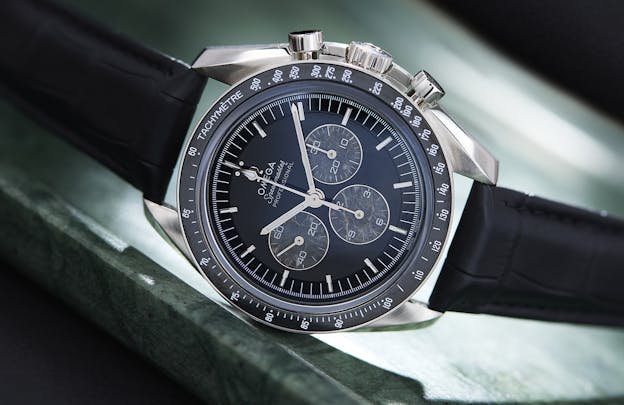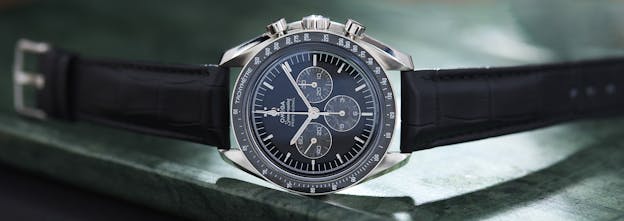The Omega Speedmaster Professional Moonwatch Caliber 321 Platinum
Proof that sometimes, they really do make ’em like they used to.
Watches based on classic models from a brand’s back catalog usually follow the same playbook, more or less – the design is generally reproduced with high fidelity to the original, and the movement is generally updated to something from the brand’s current production (which can offer some advantages, including, depending on the movement, better durability, better accuracy, and ease of service). In 2019, however, Omega did something which was more or less the exact opposite – the company announced that it would resume production, albeit in small numbers, of the famous column wheel chronograph caliber 321, which had been used to power the original Speedmasters when the model was launched in 1957.

The 311.93.42.30.99.001 was launched in a design largely identical to existing Speedmaster models, albeit with a quite lavish upgrade to the steel case of the classic Moonwatch. The new 321 was released in a platinum case, with an onyx dial and with meteorite subdials. Despite the luxurious materials, the overall effect is handsomely restrained.

In fact, if it weren’t for the meteorite insets, even a Speedmaster enthusiast might mistake the platinum 321 for a standard Speedmaster. There’s really no mistaking the heft of platinum in the hand and on the wrist, though – and the jet black onyx and meteorite give the dial a depth not found in a conventional Moonwatch. I’m as conservative a Speedmaster fan as they come – I’ve owned one, just one, for 25 years or so, and it’s a steel caliber 861, solid back, and its direct connection to the Apollo program in particular, and the history of crewed space flight in general, makes it to this day one of the most satisfying watches to wear in my (extremely chaotic) collection. But just on materials and aesthetics alone, this is an indisputably beautiful watch.
However, there’s a lot more going on than materials and aesthetics.

Omega has used several different movements in hand-wound Speedmasters over the years. The first, the caliber 321, is a three register, 17 jewel version of the 1942 CH 27 – specifically, the CH 27-12P, which was (I suppose we can use the present tense, actually) a lateral clutch, column wheel chronograph beating at 18,000 vph, with plates and bridges coated (per Omega) with a “galvanic copper” coating. In 1968-69, the 321 was replaced by the caliber 861, which upped the beat rate to 21,600 vph and swapped out the column wheel for a cam-and-lever system. The 861 was also produced as the rhodium-plated 1861, as well as the caliber 1863, which was more or less technically identical to the 861/1861 (one difference was that the 861/1861 calibers used a chronograph brake made of Delrin, a kind of nylon, and the 1863 used a metal brake; Delrin, however, is an excellent technical solution as the material provided excellent grip on the chrono seconds wheel).
Finally, in 2019, Omega updated the movement again, to the current caliber 3861. Here there was the biggest technical upgrade yet – the new movement (and watch) were Master Chronometer certified by COSC/METAS, which among other things means that any 3861 Speedmaster is resistant to magnetic fields up to at least 15,000 gauss. The 3861 also has a freesprung, adjustable mass balance, and a co-axial escapement.
For all these indisputable improvements, there was still a lot of nostalgia for the 321, although by the time the 3861 was introduced those of us who fondly remembered the 321 had long since accepted that Omega was never going to produce the movement again. However, in 2018, there was an early sign that under the right circumstances, Omega was perfectly capable of re-manufacturing vintage calibers – in July of that year, Omega introduced an extremely limited (18 pieces) edition of a wrist chronograph from its archives which used a movement, caliber 18‴ CHRO, from 1913. This launch did excite some speculation that Omega might eventually produce the 321 again, although the speculation was more wistful, wishful thinking than solid prognostication. Little did we know we had less than a year to wait – Omega announced that it was putting the 321 back into production in January of 2019, which year was also the 50th anniversary of the Apollo 11 Moon landing.

In just about every respect, the new caliber 321 is exactly the original, with the only major change being the use of Sedna gold plating rather than copper. The new movement was designed partly with the aid of tomographic scans of a vintage caliber 321; at the time of the announcement, Omega said in part, “Using the 2nd generation Calibre 321 as a reference, the OMEGA team compiled extensive historical research and original plans to reconstruct the movement as accurately as possible. Going even further, they also used “tomography” technology (digital scanning method) to see inside the true Speedmaster ST 105.003 timepiece that astronaut Eugene “Gene” Cernan wore on the moon during the Apollo 17 mission in 1972. Cernan was the last man to walk on the lunar surface and his Speedmaster is now housed at the OMEGA Museum in Bienne. Its Calibre 321 provided the perfect design criteria for OMEGA to follow.”
Even the original material for the bridge for the chronograph intermediate wheel was reproduced – the bridge is in German silver, and is visibly a different, almost greenish-grey color, from the other Sedna gold-plated bridges.

The caliber 321 is still in Omega’s current catalog in several different models (including Canopus Gold) but production is still quite low and will probably remain so for the foreseeable future. The platinum model, as the vehicle for the re-launch of one of the most important and flat-out beautiful chronograph movements of the 20th century, has a permanent place in the history of the Moonwatch, and the history of the caliber 321.

